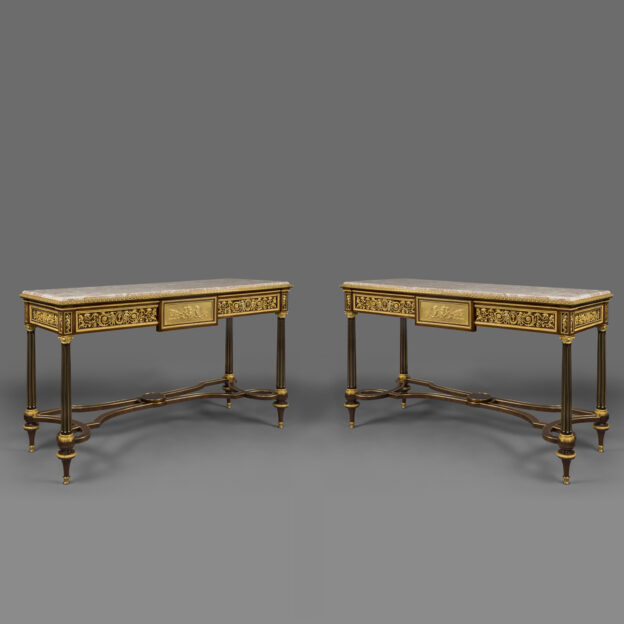Ferdinand Barbedienne
Magnifique et grande paire de candélabres figuratifs en bronze
£180,000
‘Deux Femmes Debout - porte-lumières, Style Renaissance’ A Large Pair of Gilt and Patinated Bronze Figural Torchères, Cast by Ferdinand Barbedienne,...
Dimensions
Height: 194 cm (77 in)Width: 50 cm (20 in)
Depth: 65 cm (26 in)
Description
‘Deux Femmes Debout – porte-lumières, Style Renaissance’
A Large Pair of Gilt and Patinated Bronze Figural Torchères, Cast by Ferdinand Barbedienne, Paris, From the Models by Alexandre Falguière and Paul Dubois.
Signed ‘FALGUIERE’ and ‘P. DUBOIS’ respectively and inscribed ‘F. BARBEDIENNE. FONDEUR’.

‘Grand originale, la paire’ priced at 5,500 fr. in the Barbedienne Catalogue des Bronzes d’art, 1883.
Barbedienne illustrates a drawing of this pair of torcheres on page 63 of his 1886 catalogue ‘Bronzes D’ Art’. He lists them under the heading ‘Deux Femmes Debout’ and describes them as ‘Porte-Lumières, style Renaissance’ also indicating that they were modelled by Paul Dubois and Falguière.

The model illustrated at the at the 1867 Exposition Universelle
This model of candelabra was exhibited by Barbedienne at the 1867 Exposition Universelle and subsequently installed at the Château de Compiègne as part of the refurbishment undertaken by Napoléon III and Empress Eugénie.
France, vers 1870.

A pair of torchères of the same model at the Château de Compiègne
Paul Dubois
Paul Dubois (1827-1905) entered L’Ecole des Beaux-Arts in 1858. He exhibited at the 1865 Salon the Chanteur Florentin, inspired by his period of study in Italy and later exhibited this model at the Paris Universal Exhibition of 1867 (now preserved at the Musée d’Orsay). His success brought him many important public and private commissions including a portrait for the Duc d’Aumale and a statue of Joan of Arc at Reims. He was appointed curator at the Luxembourg Museum in 1873 and went on to become Director of the L’Ecole des Beaux-Arts in 1878.
Alexandre Falguière
Alexandre Falguière studied under Jouffroy at L’Ecole des Beaux-Arts, exhibiting for the first time at the salon in 1857. He won the Prix de Rome in 1859 and continued to find extraordinary success at the International Exhibitions of the period including the Paris Universal Exhibition of 1867 where he won a first class medal. He was awarded the Ordre National de la Légion d’Honneur in 1870. As well as private commissions he undertook a number of important commissions for the French state. In 1878 he was asked by the state to realise the Triomphe de la République, placed in 1881 at the summit of the Arc de Triomphe (taken down in 1886). His most important international work was the Lafayette monument in Washington D.C.
France, vers 1870.
Date
Circa 1870
Origine
France
Moyen
Bronze doré et patiné
Signature
Signed ‘FALGUIERE’ and ‘P. DUBOIS’ respectively and inscribed ‘F. BARBEDIENNE. FONDEUR’

Ferdinand Barbedienne (6 août 1810 - 21 mars 1892) était un métallurgiste et fabricant français, connu comme fondeur de bronze.
Fils d'un petit paysan du Calvados, il débute sa carrière comme marchand de papiers peints à Paris. En 1838, il s'associe avec Achille Collas (1795-1859), qui vient d'inventer une machine permettant de créer des répliques miniatures en bronze de statues. Ensemble, ils lancent une activité de vente de miniatures de statues antiques provenant de musées de toute l'Europe, démocratisant ainsi l'art et le rendant plus accessible aux ménages. À partir de 1843, ils étendent leur champ d'action en reproduisant les œuvres d'artistes vivants et se diversifient également en fabriquant des objets domestiques émaillés. Avec le déclenchement de la guerre franco-prussienne en 1870, l'entreprise doit brièvement se reconvertir dans la fabrication de canons en raison de la pénurie de métaux, mais reprend ensuite ses activités. Après sa mort en 1892, Barbedienne est enterré au cimetière du Père-Lachaise et l'entreprise est reprise par son neveu Gustave Leblanc jusqu'en 1952.
Parmi les principaux artistes reproduits par la firme figurent Antoine Louis Barye et Auguste Rodin.
Kjellberg, Pierre. Les Bronzes du XIX siècle, Dictionnaire des Sculpteurs, Les Editions de l’Amateur, (Paris); pps.653-658.
Cooper, Jeremy. 19th Century Romantic Bronzes, pps. 25,41,149











 Imprimer
Imprimer


